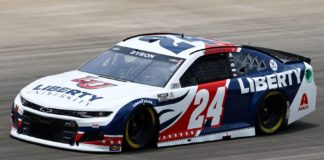Welcome to another season of chaos in the NASCAR Camping World Truck Series! Last season was quite intriguing with multiple teams contending for wins from week to week. Ultimately, Ben Rhodes with ThorSport Racing came away with the championship, despite the Kyle Busch Motorsports trucks dominating throughout the season and GMS Racing coming on strong at the end. Some drivers have moved around, but this season is sure to be just as chaotic. Let’s see what can be learned from last year to help you build winning DraftKings lineups in 2022!
In 2020 and 2021, pricing was affected by starting position due to the lack of qualifying. It was determined mainly by points standings and the most recent race results, and DraftKings was able to release pricing AFTER the starting lineup was announced. With qualifying returning this season, these trends may not hold true. However, it is expected that, for the most part, the good trucks will start near the front and the bad ones will start in the back, so there is some utility to the information below.
General DFS Lineup Construction Rules For NASCAR Trucks
- Target a minimum of 5x value for each driver. (77.3% of optimals)
- Roster at least 1 driver starting 30th or worse. (90.9% of optimals)
- Avoid punts if possible, rostering 0-1 drivers priced below $5k. (86.4% of optimals)
- Spend at least $49k of salary, unless at a drafting track. (75% of optimals)
- Roster at least 2 drivers priced above $9k, with at least one above $10k. (77.3% of optimals)
First of all, let me stress this point: Scoring in NASCAR DFS is the same across the series, but the above rules are specific to the Truck Series. The trends and drivers are not the same as the Cup Series, so DFS lineups should be individualized as well! While these rules are not absolute, they can provide a framework when building lineups, especially in cash games.
In addition to the general lineup construction rules above, there are trends that can be exploited based on track type. NASCAR can differ drastically depending on the race. Thus, winning lineups will likely employ different strategies and builds as determined by the track.
Drafting Tracks (Superspeedways)
- Don’t be afraid to leave salary on the table! The optimal lineups at Daytona and Talladega last season both spent less than $40k. While that is a little extreme, it really illustrates the amount of mayhem in this series at those tracks.
- Fade all drivers starting in the top 10. There are not enough dominator points available in these races, and they do not have access to the place differential upside of drivers starting further back.
- Roster four or more drivers starting 20th or worse. They have the most upside due to place differential points. If they can avoid the wrecks, they will be in prime position to capitalize with a good finish at the end of the race.
- Only roster drivers priced above $9k if they can provide at least 20 place differential points. It’s tempting to roster the big names, but unless they can provide place differential, they are likely bad plays. Only 3 of the top 15 DraftKings scores at Daytona last season came from drivers priced above $9k; likewise, only 3 of the top 20 scores at Talladega came from this range.
Intermediate Tracks
- Spend at least $49k of salary. 8 of 9 optimals at intermediate tracks did so last season. Again, this may be slightly different this year since pricing will be out prior to qualifying, but it’s worth noting.
- Roster no more than 2 drivers starting in the top 10. 6 of the 9 optimal lineups had exactly two drivers starting in the top 10. Typically, when targeting these drivers, the potential to obtain dominator points through laps led and fastest laps is beneficial.
- Roster 4 to 5 drivers starting in the top 25. This trend held true for 6 of 9 intermediate track races in 2021. While place differential is enticing, it is harder to come by at these tracks, especially when there are long green flag runs. Every lineup did feature at least one driver starting 30th or worse though.
Road Courses (and Pocono)
- Roster at least 2 drivers starting worse than 25th. Given the limited number of laps–and consequently, available dominator points–employing a strategy somewhat similar to a drafting track can be profitable. The drivers in this series, for the most part, struggle keeping their truck on the track at road courses.
- Do not roster more than 1 driver starting in the top 10. This is also due to the limited number of laps. It’s difficult for drivers in this range to achieve the desired 5x value unless they lead often and win.
*Note: Short tracks are not listed because the general rules listed above were applicable to all short track races in 2021. There were no additional trends noted.











